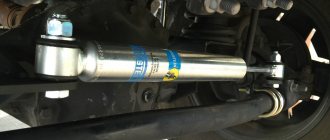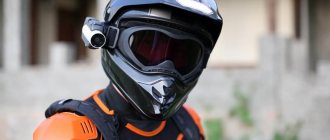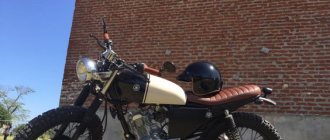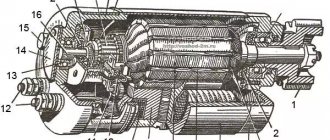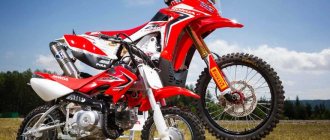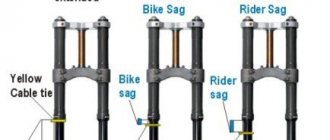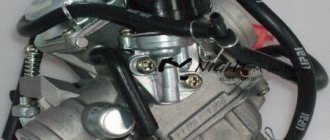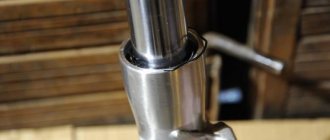Equipment requirements
Any motorcycle equipment must meet two basic requirements:
- reliably protect the motorcyclist’s body and head from injuries (scratches, bruises, fractures) not only in the event of a fall or collision, but also during the race;
- be comfortable enough and not interfere with active control and maneuvering.
Since different disciplines require different conditions for the athlete, his protective suit is adjusted to them. For example, the equipment of participants in road racing has improved aerodynamics, and for motorcyclists who prefer off-road riding, it offers greater freedom and high-quality protection from sand and dirt.
Despite such differences, a motorcycle protection kit almost always consists of a standard set of elements.
Motorcycle overalls
“Why are overalls so popular?”
“Icon Hypersport Suit motorcycle overalls - why are they so good?”
The motorcycle overalls are suitable for motorcyclists who claim to be “pro”, as they are not very comfortable for everyday riding. A person choosing overalls does this for two reasons: he knows exactly what he needs and why, secondly, he has not yet experienced the intricacies of driving around the city in overalls and having to change clothes when arriving at work.
If we are talking about the track and professionalism, then undoubtedly the overalls are a good choice, because it completely protects the pilot’s body. The biggest criticism thrown against separates is the danger of the jacket riding up and exposing your back during an accident. Such flaws do not happen with one-piece overalls.
Helmet
Head protection is an extremely important element of equipment, since the head, face and, especially, the lower jaw account for about 70% of all serious injuries.
A modern helmet is a rather complex and very well thought out product. It consists of two layers, each of which has its own meaning:
- Outer (“shell”) - takes the blow, is responsible for appearance and aerodynamics. It is made from various types of plastic - a lightweight but durable material.
- The internal soft insert is needed for effective shock absorption and comfortable wearing of the helmet. The interior is made of molded polystyrene covered with fabric.
The helmet is also equipped with a strap with a clasp, thanks to which it sits tightly on the head. Most helmets are also equipped with protective “glass” - a visor. In the case of professional sports, visors can have various enhancements, such as anti-fog, increased scratch resistance, anti-reflective coating, and others.
There are several types of helmets, but in professional motorcycle sports only two are used:
- Integral is a “classic” helmet with a molded “jaw”, a folding visor and streamlined shapes. Used in road racing.
- Cross - characterized by the presence of a visor, a reinforced, forward-projected “jaw” and the absence of a visor - instead, riders wear wide glasses. The aerodynamics of such models are worse, so when moving at high speed, the load on the cervical spine increases significantly.
And the last, quite important detail when wearing a helmet is the balaclava. It is needed for greater comfort, ease of care for the inside, and also to protect the neck from the wind.
What is more important – equipment for motorcyclists or comfort?
Motorcyclists, whether beginners or experienced bikers, take their choice of motorcycle equally seriously.
They inspect their favorite model more than once, evaluate its technical characteristics and driving performance. But are all motorcyclists so responsible when choosing clothing for a motorcyclist, or as it is called equipment for motorcyclists? Such clothing does not just protect the driver from bad weather. It can save lives in an accident. The special climate of Russia, when spring and autumn days are chilly and rainy, requires protecting the body from hypothermia. Otherwise, the motorcyclist’s reaction will worsen, and this can lead to unforeseen situations.
Special clothing for motorcyclists can greatly protect motorcyclists in some situations. Even experienced bikers cannot be insured against accidents and falls. Full equipment requires the presence of several elements. These are a helmet, pants, a jacket, motorcycle gloves, motorcycle boots and other additional, and no less important, details.
Having become accustomed to full motorcycle equipment, motorcyclists no longer feel comfortable without it. Imagine all the situations on the road and their possible outcomes when you get behind the wheel. Even at a speed of more than 80 km/h, you can become a potential morgue client. Don't rely on luck. This is at least stupid.
Equipment is divided into several types. Depending on what protective functions it is equipped with. Unprotected; non-protective, but with shockproof linings; protective. Non-protective clothing for motorcyclists will only protect you from precipitation and possibly minor abrasions. These are ordinary clothes that are made in the style of motorcycle lovers. Dense fabrics such as leather and rubber are used to sew it.
Non-protective equipment that contains shockproof protectors. Protective pads are provided in the most vulnerable areas. This type of clothing is not suitable for driving in extreme conditions. It is suitable for normal driving at an acceptable speed.
Protective equipment. It is specially designed for motorcyclists who prefer extreme riding. And it can protect against blows when falling. The main and most important characteristics of such clothing are its resistance to wear and shock resistance. Even if you fall at a speed above one hundred kilometers, a special motorcycle jacket may be damaged in appearance, but it will not fray.
Motorcycle protection is now the number one priority for most manufacturers. And special airbags have been developed specifically for extreme racing, which are inflated in some situations. They are attached to the back to protect the most vulnerable parts of the body. This is the back and neck of the racer.
All clothing items are made of durable and high-quality material; special protective linings and inserts for ventilation are used. Motorcycle boots can withstand very significant loads. Motorcycle helmets are required even for drivers of mopeds and scooters, and not just powerful motorcycles.
In addition to protection, such clothing gives a special look to the motorcyclist, causing due respect.
Jumpsuit, jacket, pants
Despite seemingly having the same function, the “structure” of clothing for road and off-road racing is radically different.
Road racing
For Superbike and MotoGP - road racing (RCR), involving high speeds, motorcycle overalls or sets of pants and a jacket securely fastened to them are used. They are made of leather and necessarily have additional inserts made of synthetic or reinforced materials in areas subject to the greatest wear. The clothing is also equipped with special protective inserts. Basically, they are designed to withstand the slipping that inevitably accompanies falling on the track.
Another distinctive feature of the MotoGP overalls is the “built-in” wear-resistant knee pads - they take the “blow” during turns, when the athlete practically touches the asphalt surface with his knee.
When developing clothes for GCS, the main thing is the convenience of sitting and controlling a motorcycle, so it always fits the body as closely as possible and even somewhat restricts movement - walking in it is quite uncomfortable. However, in the case of falls, it is the tight fit and restriction of freedom that play an important role in protecting against dislocations.
Off-road racing
Equipment for motocross and other off-road disciplines differs quite a lot, since athletes receive the main injuries from impacts and falls. To protect against them, a motor turtle and separate back protection are used. They work according to the same principle: multi-layer protective pads are attached to a fabric-mesh base that fits tightly to the body in critical places. As with a helmet, they consist of a durable plastic top that distributes the impact over a large area, and a soft foam lining. To keep the rider cool, the largest pads are perforated. Some models are also equipped with additional shoulder pads.
Back protection has a more complex design, since the spine is subject to the greatest loads, and damage to it is extremely dangerous. Some models, for example, those produced by the Italian company Dainese, in addition to a hard plastic shell and the obligatory soft layer of foamed polyethylene, have an additional layer designed to neutralize strong impacts. It is a “honeycomb” of aluminum plates that easily withstand small impacts and crumple only with strong ones, effectively dissipating energy.
Both types of protection are worn under a motorcycle jacket or jersey - a light, ventilated jacket. Both are made from breathable synthetic fabric and provide more freedom, without which maneuvering on rough terrain would be almost impossible.
The pants in a cross-country racer's uniform are also relatively light and loose, so additional accessories must be used for protection:
- “Armoured pants” are long shorts with padding in the lumbar region, tailbone, back and outer thighs. The design is similar to a motor turtle: thin ventilated fabric at the base and reinforced inserts in critical places.
- Overhead knee pads with fastening on belts. They have a rigid cup for reliable protection and a hinged joint with limited travel to reduce the load on the joint, fixing the leg in the correct position and, at the same time, providing the necessary degree of freedom.
Choosing motorcycle equipment
Once you decide to become a motorcyclist, you will inevitably face the need to purchase protective equipment. Motorists can afford to drive a car in casual clothes, because... the car reliably isolates them from external factors and protects them in the event of an accident. Motorcyclists are not protected by anything and are exposed to a large number of risks, therefore, we take the presence of equipment as an axiom and let’s try to figure out what items of equipment we need. First, you need to decide on a general approach to equipment.
On the one hand, there is never too much equipment. If you get into a motorcycle accident, the more equipped you are, the less likely the consequences of the accident will be. On the other hand, riding in jeans and sneakers is definitely more comfortable than wearing sports pants, leather pants and motorcycle boots. The conclusion follows from these two contradictions - we need to find a compromise option for ourselves that will allow us to have protection at a decent level, but not overload ourselves with equipment. Also, you need to take into account additional circumstances, for example, what kind of motorcycle you have and how you operate it. If you ride a sportbike, and even go on the track, then there can be no compromises. If you have another choice, then options are possible.
Now, in order. The only item of motorcycle equipment that, in accordance with current legislation, a motorcyclist is required to use in our country is a helmet. The helmet is the most important piece of equipment. It makes the control process not only safer, but also more comfortable. After all, even at a speed of 40-50 km/h, your eyes begin to water from the wind, and flies, grains of sand, and often stones flying towards you make the ride uncomfortable and unsafe. If you fall from a motorcycle without a helmet, the risk of serious head injury is very high. Therefore, ALWAYS WEAR A HELMET WHEN DRIVING A MOTORCYCLE!!! But there are many helmets, which one to choose. Today there are several types of motorcycle helmets.
In terms of absolute level of protection, the leader is the integral. If you plan to ride a sportbike, or any other road motorcycle, such as a roadster, sports tourer, chopper or cruiser, tourer, enduro in the city, or simply preach an aggressive riding style, we recommend that you pay attention to the integral. A high level of protection, excellent aerodynamics and, accordingly, increased comfort, excellent ventilation in good models, low weight, give every reason to make such a choice. We must not forget that, according to various sources, from 50% to 70% of impacts to a helmet during a fall occur in the jaw area. And when riding a sportbike, in our opinion, there is no alternative to the integral.
I must say that these helmets look very harmonious on a chopper. If you plan to use any of the listed types of motorcycles, except for a sportbike, and want to maintain a high level of protection, you can consider a modular. The disadvantages of modular helmets arise from the more complex design of the helmet. And the main disadvantage is the large weight compared to the integral. Well, not everyone likes extra bells and whistles, as they say. The main advantages of modular are provided to motorcyclists and heavy smokers, because... does not require you to remove your entire helmet to communicate at gas stations, in roadside stores and during frequent smoke breaks.
If you plan to drive a chopper or cruiser, then in addition to an integral or modular helmet, you can afford an open-face helmet in 3/4 format. The level of protection will be lower, but the driving style of choppers is usually calmer. Plus, many people care about a certain style that dictates the use of open helmets. Open helmets are easier to use, lighter in weight, have excellent visibility and provide good ventilation in hot weather. If you plan to drive enduro, then an integral, modular, motocross helmet and a helmet for enduro motorcycles are quite suitable for you.
When choosing your first helmet, we advise you to contact a specialized salon, where the salespeople have sufficient skills to help you. The new helmet should fit tightly, the cheeks should be compressed; if you twist your head intensely, the helmet should not rotate freely, but there should be no pain. It is advisable to try on more helmets from different manufacturers, because... Everyone’s patterns are different and you need to feel this difference. It must be admitted that all helmets that have a visor, i.e. glass fogs up in certain weather conditions. This is not comfortable and can be dangerous.
But some manufacturers equip their full-face helmets with a pinlock system. Pinlock is a plastic lens with a silicone bead around the perimeter. The system is attached to the inside of the visor and gives the effect of a double-glazed window. This is the only radical remedy for visor fogging. If you look closely at the photos of full-face helmets in our review, you will see pinlock. We advise you to pay attention to such helmets.
The next piece of equipment is motorcycle gloves. Moreover, in terms of importance, gloves, in our opinion, are in second position. Just as a motorcyclist’s helmet should be motorcycle-specific, so should gloves be motorcycle-specific. No bicycles, etc., etc., etc. gloves will not work. Motorcycle gloves must provide high-level protection and perform specific work functions. The choice of gloves should be given special attention, because... When falling, a person instinctively stretches his arms forward and they are often the first to touch the asphalt. We need effective protection.
In our review, we are considering road equipment, which is why our equipment has a road bias. So, gloves for driving on roads should be leather. No one argues that it’s so pleasant to ride in light, fabric gloves in the summer heat, but when in contact with asphalt, there is not much protection from them. We won’t even consider gloves with cut off fingers, for the same reason. If you absolutely need such an entourage, put a bandana, Cossacks and cut-off gloves in your luggage, and on the road, only in reliable equipment. Gloves should be leather, preferably with the highest possible level of protection. Perhaps consider long and short gloves.
| The first option is a helmet - integral. This is a full-face helmet that provides the maximum level of protection. An integral helmet is like a ball that completely covers the head and can be taken as a complete unit. | |
| The second option is an open helmet that does not have a jaw. It turns out that a quarter was taken away from one; such helmets are often called 3/4. 3/4 format helmets can be with or without glass, with or without a visor. | |
| The third option for an open helmet is a helmet that not only lacks jaw protection, but also barely covers the ear area. It, like half of the ball that sits on the top of the head, has a 1/2 format. These helmets do not have glasses. I think there is no need to say that the level of protection of 1/2 format helmets is very low and their use is justified only by the desire to create a certain style image. In our opinion, there are no other reasons to use 1/2 format helmets. | |
| The fourth version of the helmet is similar to the integral. Helmet manufacturers decided to combine the advantages of integrals with the convenience of 3/4 format helmets. These helmets are called modular, or flip-up. If for an integral helmet only the visor glass is raised, then for a modular one you can raise both the visor and the entire facial area, along with the jaw, turning a closed integral helmet into an open 3/4 format. | |
| For general development, let’s note the fifth version of helmets – cross helmets. Motocross is a separate topic and we will not pay close attention to it here. | |
| Well, the sixth, recently appeared type of helmets are helmets specifically for enduro motorcycles. Enduro helmets combine the advantages of motocross helmets for off-road riding with the comfort of road integrals for driving on roads of varying quality. | |
| Long gloves, like gaiters, have a part that extends high onto the forearm and provide maximum protection. When put on, long gloves ride over the sleeve of a motorcycle jacket. But in the summer heat, driving in them is not always comfortable. | |
| Therefore, you can consider a shortened version. Keep in mind that the shortened glove fits under the sleeve of the jacket, just like our regular gloves that we wear in winter. Sports motorcycle jackets, the sleeve of which goes under the bell of a long glove, are not always beautifully processed along the edge of the sleeve. Pay attention to this when choosing a jacket if you plan to use short gloves. | |
| Sports one-piece motorcycle overalls. These overalls have the highest protective characteristics. When you are on the motorcycle, in motion, they fit like a second skin and are very comfortable. But when you get off the bike, this overall will force you into a distinctive pose, with your elbows and knees bent. Plus, creaking motorcycle boots and an integral helmet in the hands will finally complete the appearance of the alien. Without the use of thermal underwear and certain skills, a one-piece jumpsuit causes difficulties when putting on and, especially, when taking off. This overall is suitable for regular use on the track, or if you are a fan of all things super sports. | |
| For everyday wear, a one-piece jumpsuit is not the best choice. An alternative to a one-piece jumpsuit is a separate jumpsuit. Separate overalls are convenient because they allow you to use the jacket separately from the pants. You can wear a motorcycle jacket and jeans on your feet. And, you can wear the jacket with pants, which are fastened to the jacket with a zipper. Such overalls give much more freedom in choosing combinations for everyday use and do not create a very pronounced motorcycle racer’s pose. If you are planning to buy a motorcycle for aggressive riding - a sportbike, roadster, sports tourer, and perhaps an enduro, buying a two-piece suit will be the most practical purchase. On choppers and cruisers, in overalls, you will look, let’s say, strange. | |
| The next piece of equipment is a motorcycle jacket. The vast majority of motorcycle jackets already have built-in protection for the shoulders and elbows. The back either has no protection at all, or has some kind of rubber-foam insert, which is of no use. The back needs additional protection. Because Since the jackets have an insert pocket to protect the back, we have two options. | |
| The first is to buy a rigid insert and replace the standard back protection with it. Thus, when we put on a jacket, we, at the same time, put on protection. This is probably the most practical way. | |
| The second option is to buy a separate back protector with straps and wear it under your motorcycle jacket. By the way, there is also the so-called turtle, this is when plastic pads are attached to the base, in the form of a mesh, to protect the back, shoulders, elbows and chest. | |
| Many people buy turtles for riding in hot weather, because... The turtle's breathability is higher than that of the jacket. The turtle does not provide sufficient fixation of the plastic shields and, upon contact with asphalt, they can move out of their place and there will be no protection. The turtle must be secured and worn under a motorcycle jacket. Keep in mind that a separate back protector or turtle will greatly increase your size and, if you decide to use such a piece of equipment, you need to try on the motorcycle jacket over the back or turtle. | |
| Motorcycle pants. There is a point in buying separate sports motorcycle pants if, after purchasing a separate motorcycle jacket, you subsequently feel the need for this. Of course, it is better to plan this right away and, if you plan to use motorcycle pants, buy a two-piece motorcycle overalls. | |
| You can also wear motorcycle jeans on your feet. Motorcycle jeans differ from ordinary jeans in that they are additionally reinforced, for example, with Kevlar thread, and the seams have additional stitching. This is done so that they do not separate when dropped. Ordinary jeans, when in contact with asphalt, simply decay like paper in a matter of seconds. There is an old saying that jeans, skin and bones wear off on the asphalt very quickly. Sports, leather motorcycle pants have full built-in protection. Motorcycle jeans come with internal pockets for built-in protection, and some without. | |
| In any case, it is better to use separate knee pads that are attached directly to the body, because... Padded knee pads can move if you fall. A very good addition to motorcycle jeans is pelvic protection. These are plastic plates that are placed on a stretchy mesh and are worn like underpants. The pelvic protection covers the hips and tailbone. | |
| Motorcycle boots. Our feet can be seriously injured when falling from a motorcycle. Therefore, one of the most important pieces of equipment is motorcycle boots. Let’s say right away that riding in sneakers is definitely more convenient. So, if you tolerate discomfort, then for maximum protection. In the line of any serious motorcycle shoe manufacturer, we choose either the top-end or the penultimate model. | |
| Today, shortened motorcycle boots have appeared that look like high-top sneakers. They provide less protection, but are also not very bad. And definitely don't allow yourself to ride without leg protection. The ankle joint is very vulnerable. A variety of models allow you to choose shoes for any type of motorcycle. |
Let's try to summarize. The required minimum is a helmet, gloves, a motorcycle jacket with built-in protection, knee pads and motorcycle shoes. The rest is very desirable. If you find it difficult to decide on the choice of motorcycle equipment, come to the motorcycle school at the Presidential Academy and we will definitely help you!
Shoes
Road and cross-country boots are tall shoes that cover the ankle and lower leg and have a snug fit. Under the high, dense shin protection, as in the case of other parts of the equipment, there is a soft layer hidden.
Shoes for MotoGP are initially designed to fit the motorcycle and provide reliable protection against friction on the asphalt, so walking in them is extremely uncomfortable. Cross boots are a little softer on the flex as the rider has to constantly change gears. To achieve this, by the way, the material on the instep of the foot is reinforced with wear-resistant overlays. And, of course, exclusively synthetic surfaces are used, since off-road driving is, in the literal sense, a dirty activity.
Another difference concerns small but important overlays. Motorcycle boots for road racing have a plastic pad on the outside of the toe - a slider. Its essence is exactly the same as that of the “built-in” knee pad - to ensure safe contact with the road surface when entering a turn. The sliders wear out quickly, so the design of the boots initially allows them to be easily replaced.
There is no slider in cross-country motorcycle boots - here it is simply not needed, but instead a durable steel pad is used, located in the center of the sole. It is necessary to protect the boot from abrasion on the footboards and the ground.
Gloves
And the last, but by no means least important, element of a motorcycle athlete’s equipment is gloves. With them, relative to other elements of clothing, everything is quite simple. Gloves can be short or long - to protect the wrist during cross-country racing; light (perforated) - for hot summer weather or dense, waterproof - for rain and cold. The materials used, as in previous cases, are thick leather or durable synthetic fabric, as well as plastic to strengthen the phalanges of the fingers and the back of the hand.
Another interesting point: there are both classic gloves with five fingers, and models where the ring finger and little finger are connected together. This is necessary in order to protect the latter from dislocation or fracture during a fall.
Jackets
Traditionally, leather is often used to make motorcycle jackets. And this is exactly the material that can really protect a motorcycle racer. Although textile models have recently been able to compete with leather ones.
Leather motorcycle jacket
The quality of a leather jacket depends not only on the thickness and quality of the leather itself (by the way, it should not be thinner than one millimeter), but also on the quality of the seams. Such jackets are more suitable for wearing in cold weather and are more repairable. However, they also have disadvantages: lack of water resistance, poor ventilation.
Textile
Textile jackets are made from materials such as carbon, Kevlar, and nylon. The design includes ventilation valves and rigid protective inserts. You can purchase models with removable warm linings. By the way, it is much easier to choose such a jacket in some brighter color in order to be more noticeable on the road, since the range of colors is wider than in the line of leather models.
Special details:
- It’s good if the jacket has protective inserts in the elbows, shoulders and back.
- When driving at night or in bad weather conditions, reflective strips will serve you well.
- If you choose a motorcycle jacket that fits tightly, it will be impossible to keep warm in cold weather; choose models that are a little looser.
Note!
It's better to have several jackets for different conditions.
